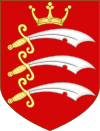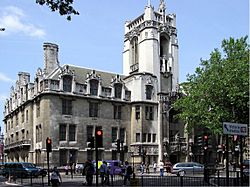Middlesex County Council facts for kids
Quick facts for kids Middlesex County Council |
|
|---|---|

Coat of arms of the Middlesex County Council
|
|
| Type | |
| Type | |
| History | |
| Established | 1 April 1889 |
| Disbanded | 1 April 1965 |
| Preceded by | Middlesex Quarter Sessions |
| Succeeded by | Greater London Council |
| Seats | Councillors and aldermen |
| Elections | |
|
Last election
|
1961 |
| Meeting place | |
 |
|
| Middlesex Guildhall, Westminster | |
The Middlesex County Council was an important local government group in the area of Middlesex, England. It was in charge from 1889 until 1965. This council helped manage many parts of daily life for people living there.
The council was created by a law called the Local Government Act 1888. This law also took away the busiest part of Middlesex to create a new area called the County of London.
Contents
How the Council Was Elected and Controlled
The county council was made up of two types of members: elected councillors and special members called county aldermen. All the councillors were chosen by voters every three years. Aldermen were extra members, with one alderman for every three councillors. They served for six years, and half of them were chosen by the councillors right after each election.
The very first elections happened in January 1889. The first meeting of the new council was held on February 14, 1889, at Westminster Town Hall. At first, the council members didn't use political labels. However, some of the aldermen chosen were from the Conservative Party.
After 1919, members of the Labour Party started to be elected, which changed the council's political mix. The elections in 1922 and 1925 mostly didn't follow party lines. By 1928, most of the council members were called "Moderate," with Labour forming the main opposition.
Labour gained more seats in the 1931 election. This led to the creation of the Middlesex Municipal Association. This group included all members who were against the Labour Party. It was supported by the Conservative Party, even though it wasn't officially part of it. This association controlled the council until 1946.
In 1946, the Labour Party took control of the county council for the first time. After this, the Conservative Party actively ran in elections. They won control in 1949 and kept it through the 1952 and 1955 elections. In 1958, Labour won control again.
The last elections for the county council were held in 1961, and the Conservatives won. The elections that were supposed to happen in 1964 were cancelled. This was because of a new law, the London Government Act 1963. Instead, elections were held for the new Greater London Council.
Leaders of the Middlesex County Council
The chairman of the county council led its meetings. They also represented the council at special events, much like a mayor does for a town. Twenty-nine different people served as chairmen during the council's time.
| Years | Chairman | Notes |
|---|---|---|
| 1889–1908 | Ralph Daniel Makinson Littler | Knighted in 1902 |
| 1908–1909 | Montagu Sharpe | Knighted in 1922 |
| 1909–1919 | William Regester | |
| 1919–1924 | Cecil Fane De Salis | Made a Knight Commander of the Bath in 1935. |
| 1924–1927 | Benjamin Todd | |
| 1927–1930 | Charles Pinkham OBE | Knighted 1928. Former MP for Willesden West. |
| 1930–1933 | George Marlow Reed | |
| 1933–1936 | Howard Button | Knighted 1936. Former MP for Wrekin. |
| 1936–1937 | Sir William Prescott | Became a baronet in 1938. Former MP for Tottenham North. |
| 1937–1940 | Forrester Clayton | |
| 1940–1943 | Sir Gilfrid Gordon Craig | |
| 1943–1946 | William Reginald Clemens | |
| 1946–1947 | Bernard Harry Rockman | |
| 1947–1948 | Frederick Messer | First chairman from the Labour Party. MP for Tottenham South and Tottenham. Knighted 1953. |
| 1948–1949 | William John Irving | |
| 1949–1951 | Albert Henry Farley | |
| 1951–1953 | William Josiah Grimshaw | Knighted 1953 for public service. |
| 1953–1954 | Sir Archer Hoare | |
| 1954–1955 | Albert Noel Hansel Baines | |
| 1955–1956 | Stanley Graham Rowlandson | Knighted 1956 |
| 1956–1957 | Christopher George Armstrong Cowan | Knighted 1958 |
| 1957–1958 | William Rendel Myson Chambers | |
| 1958–1959 | Thomas Henry Joyce | |
| 1959–1960 | George Albert Pargiter | MP for Spelthorne and Southall. Later became a Lord. |
| 1960–1961 | Muriel Rose Forbes | |
| 1961–1962 | Sir Joseph Haygarth | |
| 1962–1963 | James Henry Knaggs | |
| 1963–1964 | Frances Timpson | |
| 1964–1965 | John Wilfred Barter MP | MP for Ealing North |
What the Council Did for the Community
The Middlesex County Council had many important jobs and responsibilities. Here are some of the main ones:
- Roads and Bridges: They built and made wider major roads like the Great West Road and the North Circular Road. They also worked with another council to manage bridges over the River Thames. Some bridges they built or rebuilt include Kew Bridge and Hampton Court Bridge.
- Education: In 1891, the council started offering technical education. By 1902, they were in charge of secondary schools across the county and primary schools in some areas. After the Education Act 1944, they became responsible for all education. When the council closed, it managed hundreds of primary and secondary schools, plus special schools and colleges. Some of these colleges later became University of Middlesex and Brunel University London.
- Library Service: They ran the county's public library system.
- Public Hospitals: After 1930, the council took over several hospitals, such as Chase Farm Hospital and North Middlesex Hospital. These hospitals later became part of the National Health Service in 1948.
- Emergency Services: They managed the Middlesex Fire Service and the Middlesex Ambulance Service starting in 1948.
- Drainage and Sewage: They were responsible for the main drainage and sewage systems.
- Vehicle Taxes: They handled taxes for motor vehicles from 1909.
- Town Planning: They were involved in planning how the county would develop from 1948.
- Other Duties: This included making sure weights and measures were correct and setting up coroner's districts.
Key People Who Ran the Council
Here are some of the main officers who helped run the county council during its 76 years:
Clerk of the County Council
- 1889-1909: Sir Richard Nicholson
- 1909-1918: Walter George Austin
- 1919-1935: Ernest Walter Sidney Hart (knighted in 1935)
- 1935-1954: Clifford Walter Radcliffe (knighted in 1953)
- 1955-1965: Kenneth Goodacre – he later became a Deputy Clerk for the Greater London Council.
County Engineer and Surveyor
- 1889-1898: Frederick Hyde Pownall
- 1898-1920: Henry Titus Wakelam
- 1920-1932: Alfred Dryland
- 1932-1949: William Henry Morgan
- 1949-1965: Henry Stuart Andrew
Chief Education Officer
- 1945-1952: Thomas Benjamin Wheeler
- 1952-1965: Cecil Ernest Gurr
Chief Officer of Fire and Ambulance Service / Chief Fire Officer
- 1948-1963: Alfred Wooder
- 1963-1965: Frank Stephen Mummery
Why the Council Was Replaced
Middlesex was a fixed-size area, but the number of homes there grew a lot. It went from about 236,000 homes to over 665,000 homes in forty years leading up to 1961. This growth showed that by 1951, Middlesex was really part of the larger London city area.
Because of this growth and change, the Middlesex County Council was officially ended in 1965. A new, bigger council, the Greater London Council, was created to manage the whole London area. Most of Middlesex became part of this new Greater London. However, a few parts, like Staines, Sunbury-on-Thames, and Potters Bar, were moved to other nearby counties like Surrey and Hertfordshire.

